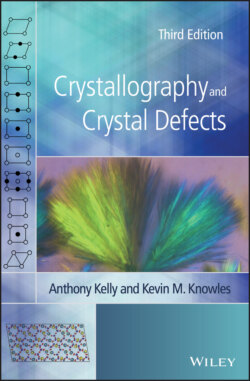Читать книгу Crystallography and Crystal Defects - Anthony Kelly - Страница 48
2.15 Groups, Subgroups, and Supergroups
ОглавлениеIt is evident from the discussion in this chapter on point groups and space groups that each point group and space group consists of a self‐consistent finite set of symmetry operations. Therefore, point groups and space groups can be described in the formalism of group theory [17–19]. A group G is a set of elements g1, g2, g3 … gn which conform to the following four conditions [19]:
1 The product gigj of any two group elements must be another element within the group.
2 Group multiplication is associative: (gigj)gk = gi(gjgk).
3 There is a unique group element I called the identity element belonging to G so that its operation on a member of the group g is such that Igi = giI = gi.
4 Each element within the group has a unique inverse; that is, for each gi there is a unique element gi−1 so that gigi−1 = gi−1 gi = I.
Thus, for example, following the example of the point group mmm used by de Jong [5], p. 20, the eight group elements within this point group are: the identity, I; three 180° rotations about the x‐, y‐ and z‐axes; three reflections in the (100), (010) and (001) planes; and a centre of symmetry. A subgroup of these symmetry elements is found in 2mm: the identity, a 180° rotation about the x‐axis and two reflections in the (010) and (001) planes. Other subgroups are the point groups 222, 2/m, m, 2, , and 1. Conversely, the point group mmm is clearly a supergroup for 2mm and 222.
Similar principles apply to subgroups and supergroups of space groups. Thus, for example, following Hans Wondratschek in chapter 8 in Volume A of the revised, fifth edition of the International Tables for Crystallography [20], the space group P2m is one member of the group whose minimal nonisomorphic supergroup is P63/mcm; it has as maximal nonisomorphous subgroups P, P321, P31m and Pm2m. (Groups are termed isomorphic if they have an equivalent group multiplication structure, but differ in the nature of the elements constituting them [19]. Thus, for example, the point groups 2/m, 222 and 2mm are isomorphic: all three have four elements within the group and the same multiplication structure within them.)
